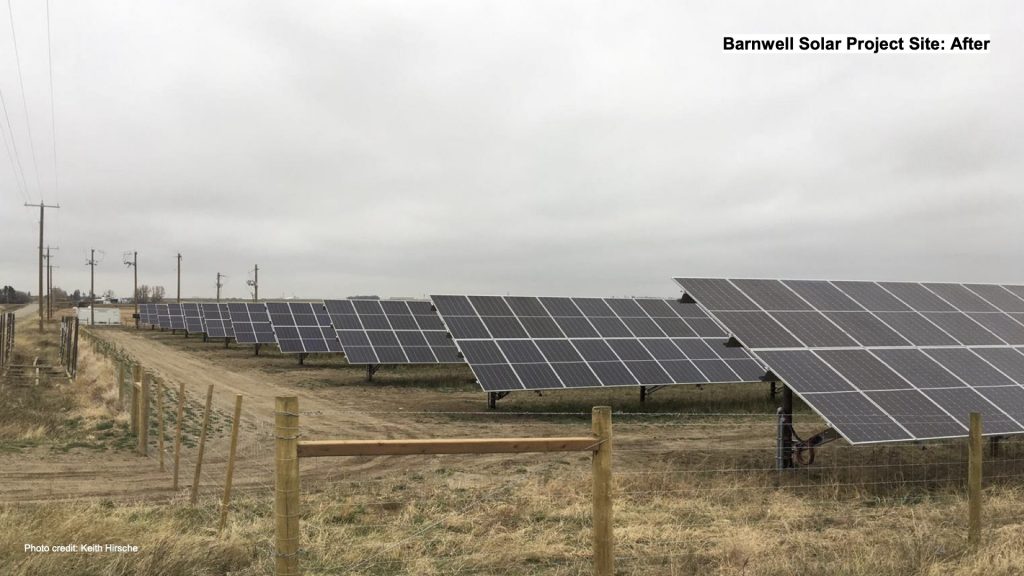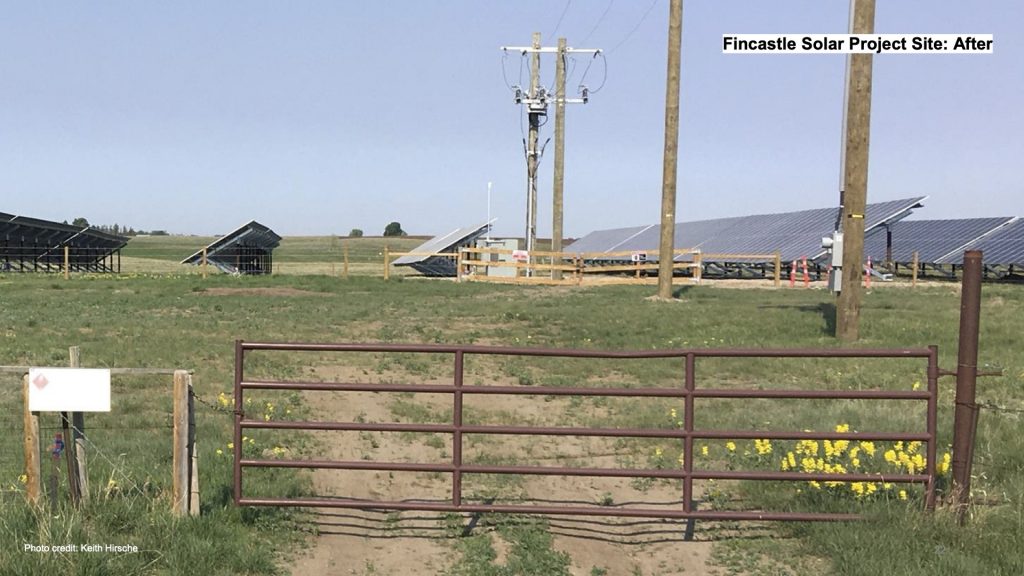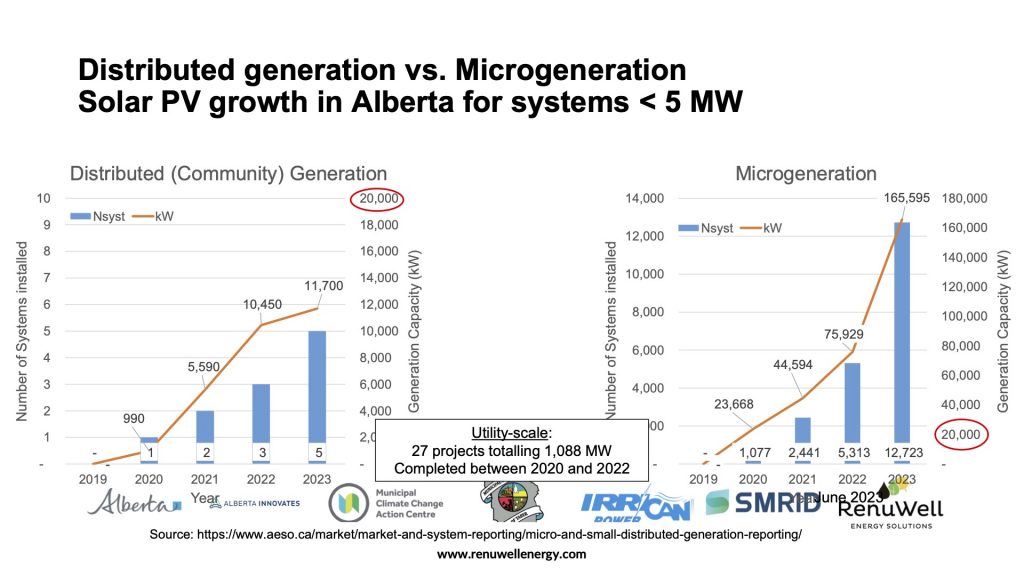By David Dodge, GreenEnergyFutures.ca
RenuWell just might be the best example of energy transition imaginable, so why isn’t the idea taking off?
RenuWell is the brainchild of Keith Hirsche, a farm kid from Taber, Alberta who worked in the oil industry for a time, as many farmers do.
The idea is quite simple. Take an abandoned oil well and transform it into a small solar farm.
There are about 466,000 oil wells in Alberta, about one-third are active and 170,000 are suspended or abandoned.
Abandoned oil wells are a $33 billion liability in Alberta and many have been sitting dead in the water for decades annoying farmers, small towns and counties everywhere. In addition, municipalities say they are owed $245 million in taxes.
Add to this the cost of oil production is going up and the cost of solar production is going down, way down.
We first did this story a few years ago but we’ve wanted to do a deeper dive and to show you the finished projects so we visited the two pilot projects near Taber last year.
So headed off 10 kilometres southwest of Taber to the Barnwell site.



Pilot transforms two abandoned well sites into solar farms
“This site had been an orphan well site…since I believe around 1980. It had caused a bunch of problems for the landowner,” says Daryl Bennett, an associate of RenuWell, who is also a director with the local and Alberta surface rights organizations.
“He’s a specialty crop grower. He grows Taber corn and vegetables and this site was heavily contaminated,” says Bennett. “It took quite a few years for it to get cleaned up.”
So Bennett introduced the landowner to the RenuWell idea.


The site is about four acres in size and RenuWell installed 860 kilowatts of solar, enough power to run 55 irrigation pivot systems and their pumps.
The second site is called the Fincastle Site another former orphan well site located 11 kilometres northeast of Taber. They were able to install 591 kilowatts of solar there.
RenuWell partnered up with the MD of Taber, Irrigation Canal Power Co-op Ltd., SkyFire Energy, Iron and Earth and Medicine Hat College to carry out the pilot projects. We’ve done stories before on SkyFire Energy and Iron and Earth that worked with the Louis Bull Tribe to conduct similar training for First Nations and oil workers.
The Alberta government, through the Municipal Climate Change Action Centre provided about half of the funding and it was tied to piloting a Community Generation Power project. Together with Iron and Earth and the college they also ran solar training programs for First Nations and oil and gas workers.



Common sense energy transition solution
The idea makes sense on so many levels says Darryl Bennett:
- It replaces lost lease payments to landowners and lost taxes to the municipal district
- It reuses roads, connections to the grid and other infrastructure from the well site and reduces reclamation costs and uses existing grid infrastructure
- Solar produces electricity at the same time demand grows from irrigation thus “stabilizing our local grid with renewable energy.”
- “A lot of the power generated from this site will never hit the transmission lines. It will be used by neighbours right around here by their pivot systems.”
- “It’s kind of a brownfield site that the landowner doesn’t need – we’re not using prime agricultural land.”
- It’s a small-scale investment opportunity for communities, irrigation districts, farmers and others
Darryl Bennett says the concept reduces reclamation costs and he believes it could even accelerate the reclamation process and possibly even provide revenue while sites are being rehabilitated if the rules were more flexible.

A thousand points of light
Keith Hirsche and Darryl Bennett both see this as an incredible investment opportunity that helps solve the problem with abandoned oil wells and builds new revenue-producing projects that will live long into the future.
They’ve run the numbers. If solar was installed on just 10 per cent of inactive oil leases the result would be 6,200 megawatts of solar capacity that could produce $650 million in annual revenue and create 55,900 person-years of employment.
For reference that is 13 times more solar capacity than Travers, the largest solar project in Canadian history, located near Vulcan, Alberta.

RenuWell’s numbers – If 10% of well sites were transformed into solar farms
| Leased land converted to solar | 31,000 acres |
| Installed solar generation | 6,200 MW |
| Annual production capacity | 8,092,000 MWh |
| Annual CO2 savings | 4,531,360 megatonnes |
| Annual revenue generated | $650 million |
| Total investment (solar and abandonment) | $11.1 billion |
| Deferred reclamation expenses | $155 million |
| Person-Years employment | 55,900 |
So why isn’t this idea taking off like crazy
The answer to this question is complicated, but most of it has to do with unfriendly regulations and red tape and a government that, to put it politely hasn’t shown much interest.
The two pilots were carried out as community solar projects, a condition of the funding. It’s really important to understand how projects are classified and regulated in Alberta to understand the barriers.
Microgeneration
Alberta’s microgeneration regulation is by all accounts very successful and has resulted in more than 12,000 solar systems under five megawatts being installed in Alberta. In plain language, the way it works for smaller (<150 kW) systems is you can install only as much solar on your building as you need to satisfy its power demand on an annual basis. In the summer when you overproduce you are compensated for power sold to the grid at the same rate you buy power. The cost of connection is negligible for the microgenerator.
Small Scale Power Producer
Small Scale Power Producer projects can be quite small, well within the microgenerator size of, five megawatts but the generator must complete a basic connection study which costs about $4,000 and then a detailed study which costs about $10,000. This all takes time, often more than a year. And then the transmission company can request a $30,000 transmission study which can add another two years to the project timeline. Community generation is essentially a version of a small-scale producer in which the project proponents itemize community benefits as part of their project. Electricity is sold to the grid at market rates. Smaller producers find this process very onerous and very few projects have been carried out.

The RenuWell idea works, but how to scale up?
The two RenuWell pilot projects were developed as Community Generation under the small-scale generator regulation. This means it was fairly costly and it took almost two years to develop these relatively small solar projects.
Trevor Helwig is the Engineering and Technical Services Manager with the St. Mary’s Irrigation District who co-developed and now owns the two RenuWell pilot projects.
He says the two projects are “working very well and they “help balance the grid and shave those peak times when irrigation is affecting the load in a localized area.”
As of late summer, the two sites were producing more electricity and revenue than projected.
“We’ve proven the concept and it can be a financial driver for the area. We’d like to see more of these sites developed,” says Helwig. His caveat is that projects like this may need to be developed as a grouping or aggregate of multiple projects to benefit from economies of scale.
It’s a “fantastic repurposing of orphan well sites…that is generating revenue coming back to us as a utility and for the landowner in the form of lease payments,” says Helwig.

Reduce red tape and investment will flow
If a few things were changed his organization and others might be interested in getting more involved in developing such sites, he says. What’s needed is to remove some of the uncertainty of the interconnection process, a much simpler, less expensive process that takes six months instead of two years and the ability to aggregate projects to benefit from economies of scale.
Changes to the microgeneration regulation a few years ago do allow for the concept of “adjacency” which is how Raymond, Alberta was able to go net-zero on its electricity by building a solar carport at their sports facility to supply power for streetlights and a swimming pool that couldn’t fit enough solar on the roof. But the concept is poorly defined and open to a wide variety of interpretations.
But one could imagine this concept working very well for irrigation districts that would install one small solar farm on a well site and power dozens of “adjacent” irrigation pivots and pumps.

Bennett says most of the power from projects like these will never reach the transmission lines and will be used via the local distribution lines. Since the power will be used locally by simply better utilizing existing distribution infrastructure the amount of studies and red tape could be drastically reduced.
Essentially if the small power producer regulation were simply amended to work more like the microgeneration regulation for smaller (<5 megawatt) projects you would see an explosion of projects just like these creating local power, from small producers on abandoned well sites.

The proof is in the pudding.
The microgeneration regulation has resulted in more than 12,000 small solar projects being developed in Alberta, while just five have been developed as small-scale community generation projects, two of which were the RenuWell projects.

